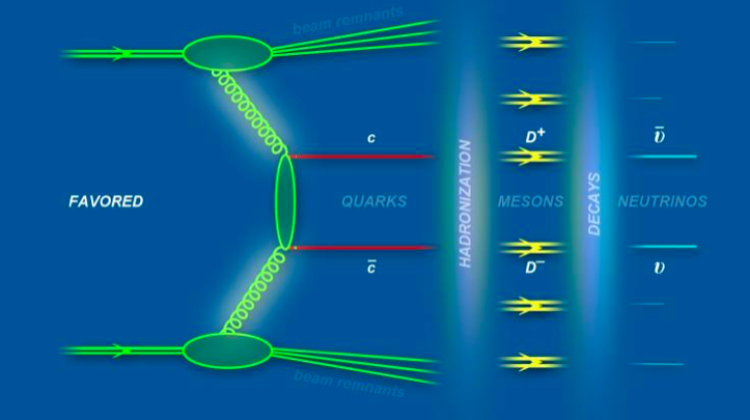Matter-antimatter asymmetry may interfere with the detection of neutrinos
 Comparison of mechanisms of favoured and unflavoured fragmentation of quarks. (Source: Institute of Nuclear Physics PAS)
Comparison of mechanisms of favoured and unflavoured fragmentation of quarks. (Source: Institute of Nuclear Physics PAS)
CERN experiment has shown that charm mesons and their antimatter counterparts are not produced in perfectly equal proportions. Physicists from Kraków propose their own explanation of this phenomenon. Their results may have implications for neutrino research.
In the first moments after the Big Bang, the Universe was filled with equal amounts of particles and antiparticles. While it was cooling down, matter and antimatter began to merge and annihilate, converting into radiation. Why did some of this matter, from which the present Universe is built, survive this conflagration? In order to decipher this great mystery of modern science, physicists are trying to better understand all mechanisms responsible for even the smallest disproportions in the production of particles and antiparticles.
A group of scientists from the Institute of Nuclear Physics of the Polish Academy of Sciences in Kraków, associated with the LHCb experiment at the Large Hadron Collider in Geneva, recently looked into one of these processes: the asymmetry occurring at the birth of charm mesons and antimesons. The conclusions from the analysis could have tangible practical significance. The institute representatives informed about the research in a release sent to PAP.
According to modern knowledge, quarks are the most important indivisible building blocks of matter. We know of six flavours of quarks: up (u), down (d), strange (s), charm (c), bottom (b) and top (t); each flavour also has its own antimatter counterpart (often marked with a dash above the letter, read as “bar”).
Quarks are generally formed in quark-antiquark pairs. They are extremely sociable particles: almost immediately after coming into being, they bind into hadrons, or groups of two, three, and sometimes more quarks or antiquarks, bonded with gluons (particles that transfer strong nuclear interactions). The process of combining quarks/antiquarks into complexes is called hadronization.
Unstable hadrons built from quark-antiquark pairs are called mesons. If one of the quarks in a meson is a charm quark, the particle is called a charm meson and is denoted by the letter D (or for the charm antiquark: D with a bar above it). A pair built of a charm quark and a down antiquark is a D+ meson, and one consisting of a charm antiquark and down quark is a D- meson.
An interesting asymmetry has been noticed in the measurements conducted in the last quarter of a century, including recently as part of the LHCb experiment. It turns out that D+ and D- mesons are not always produced in exactly the same proportions. In the case of the processes observed in LHCb, initiated in collisions of counter-current beams of high-energy protons, this asymmetry was small, less than one percent.
"Charm quarks are mainly formed during gluon collisions in so-called hard interactions, and after birth they hadronise into D mesons. We investigated another meson formation mechanism, known as unfavoured quark fragmentation. Here, the charm meson is created as a result of hadronization of a light (up, down or strange) quark or antiquark. By means of the nuances of this mechanism, the asymmetry between kaons and antikaons, i.e. K+ and K- mesons, was explained earlier. But until now it has not been investigated whether a similar mechanism could explain the asymmetry between the relatively massive D+ and D- mesons" - says Dr. Rafał Maciula (Institute of Nuclear Physics PAS), the first author of the publication in Physical Review D.
The research of the physicists from the Institute of Nuclear Physics PAS may have significant consequences for neutrino observatories, such as the IceCube Observatory in Antarctica. This detector, in which 49 scientific institutions from 12 countries collaborate, monitors a cubic kilometre of ice located almost a kilometre below the surface, using thousands of photomultipliers. Photomultipliers track subtle light flashes initiated by the interaction of ice-forming particles with neutrinos, elementary particles that interact very weakly with ordinary matter.
IceCube registers several hundred neutrinos a day. It is assumed that neutrinos with significant energies have reached the detector directly from distant cosmic sources: supernovae or merging black holes or neutron stars.
"Some of these processes, resulting in the formation of neutrinos with high energies, take place with the participation of D mesons. Meanwhile, we show that the mechanism of production of these mesons in the atmosphere can be much more efficient than previously thought. So, if our assumptions are confirmed, some of the registered highly energetic neutrinos, now considered to be of cosmic origin, have actually appeared just above our heads and are disturbing the real picture of events in the depths of space" - explains Prof. Antoni Szczurek (Institute of Nuclear Physics PAS).
The model proposed by physicists from Kraków currently has the status of a hypothesis. But researchers suggest a way to verify it. They believe that it would require directing a single beam onto a stationary target in the LHC accelerator.
Research on asymmetry in the production of charm mesons was financed from the statutory resources of the Institute of Nuclear Physics PAS and a National Science Centre grant.
PAP - Science in Poland
lt/ agt/ kap/
tr. RL
Przed dodaniem komentarza prosimy o zapoznanie z Regulaminem forum serwisu Nauka w Polsce.















